[Submitted as a REVIEW]
Introduction
Odepro is a flashlight manufacturer I first learned of earlier this month after OdeproOutdoor became active on CPF. I volunteered to review the KL41, one of several models of flashlights that Odepro manufactures.
This light was provided by OdeproOutdoor for review and shipped from an Amazon distribution center in the U.S. The KL41 being reviewed here is the Kit version and includes a remote switch, 2 batteries, and a 2-bay charger.
Here's the key review details in one table:
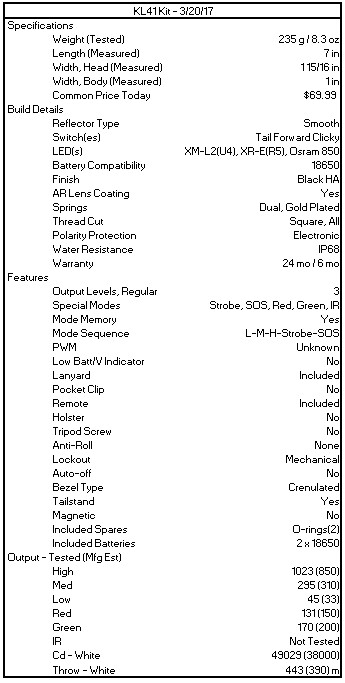
Packaging
The KL41 kit arrived in a well-made gloss black box with a magnetic clasp and sufficient padding for all of the components included. It is not a travel case per se, but it did a good job protecting the contents while in transit and held up to several dozen cycles of opening and closing while I was performing this review. Unfortunately, the box included no instructions or user manuals, though spare o-rings were included.
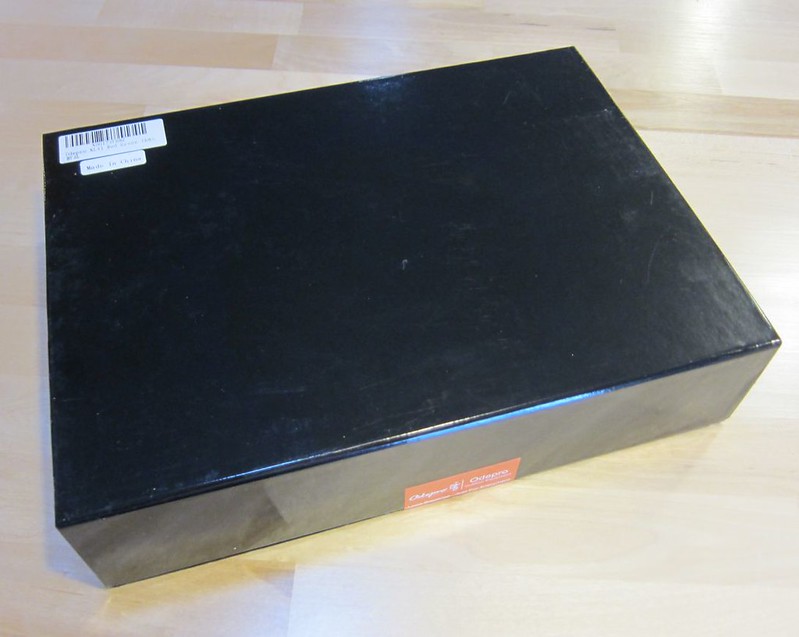

Here is the user manual from Odepro's website:
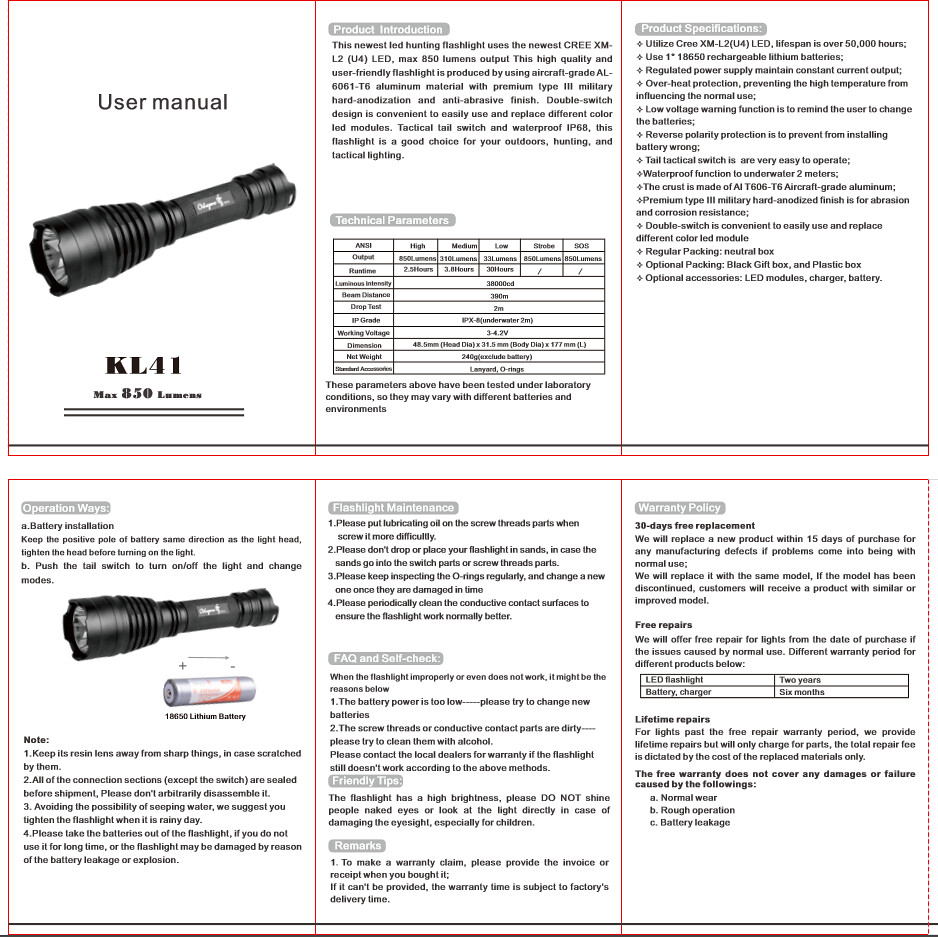
Design
The KL41 is marketed by Odepro as a "Super Bright Long-range Tactical Hunting Flashlight." How can it be long-range, tactical, and hunting all at the same time? A very unique approach – user swappable LED modules. Separate modules are included for the WHITE (XM-L2), RED (XR-E), GREEN (XR-E), and INFRARED (Osram) emitters. Each has its own battery spring, driver, and emitter. White, green, and infrared modules are labeled, though red curiously lacks any such distinction.
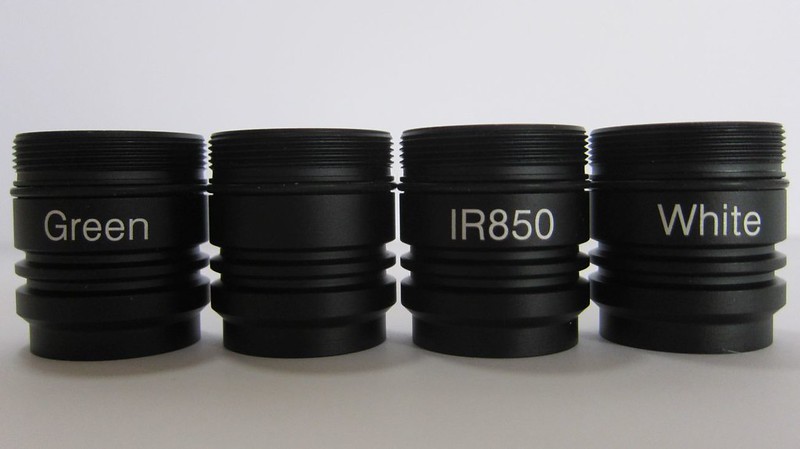
Each LED module is packaged in its own storage jar with foam inserts to cushion the module and protect the LED. The emitter itself is mounted to a copper star of thickness between 1.5-2.0mm. Sufficient thermal paste was applied between the star and body to ensure good heat transfer.
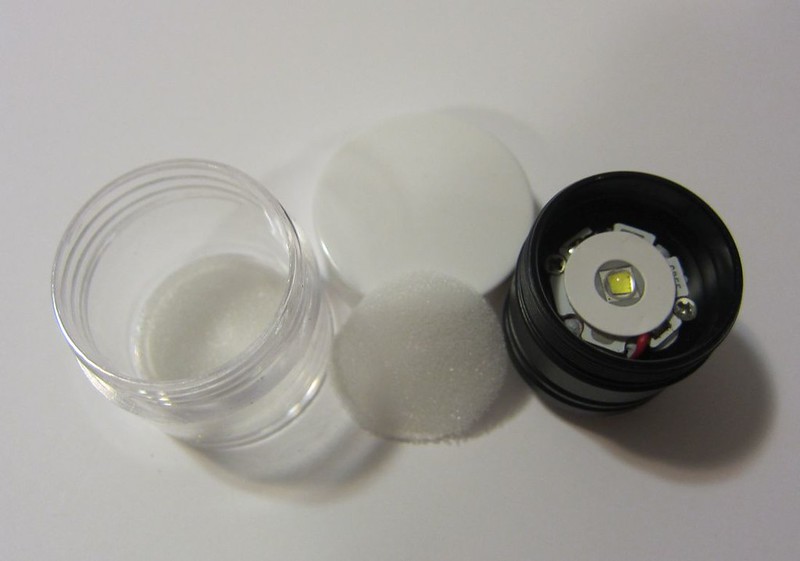
Unlike other lights that tuck colored LEDs into the walls of the reflector, the KL41 uses one emitter at a time as selected and assembled by the user. The advantage is that the full reflector can be utilized – producing an artifact-free beam and achieving long throws regardless of emitter. The disadvantage is that swapping between LEDs means disassembling the flashlight and then reassembling with the alternate LED module. As discussed in the Problem section later, this design decision introduces a point of possible failure that I experienced while performing this review.
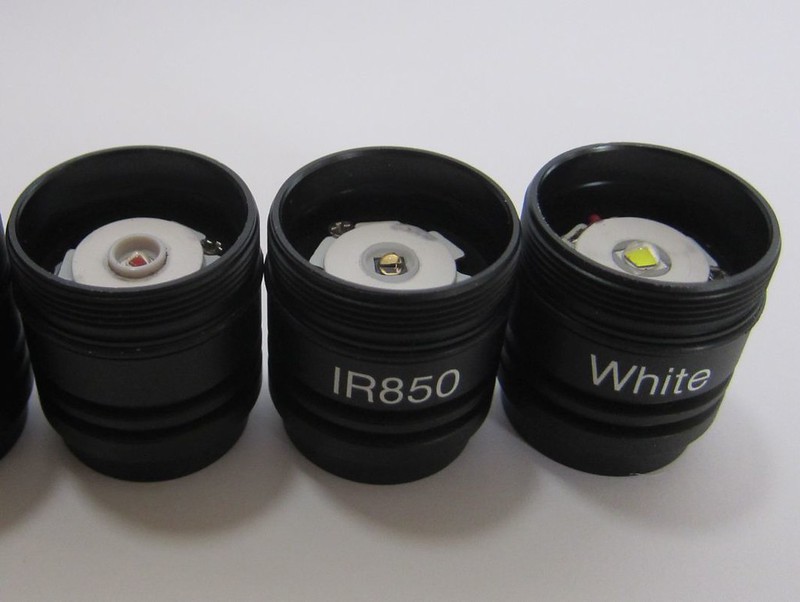
The LED modules each contain gold-plated springs for the positive end of the battery. The KL41's manual reports that the light has polarity protection; I did not test this to confirm.

The KL41 disassembles into 4 pieces in total: head, LED module, body tube, and tail.
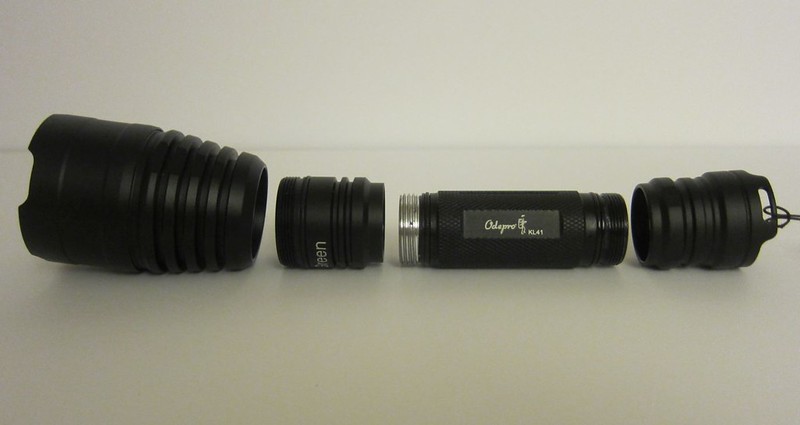
The Odepro logo and model number are printed on the side of the battery tube along with an image on the opposite side showing the correct battery orientation. The anodization and printing were both excellent and free of defects. The diamond pattern knurling is one of the least aggressive I've seen. With the larger head and tailcap I don't see slippage being a real problem, but the knurling itself is nearly smooth.
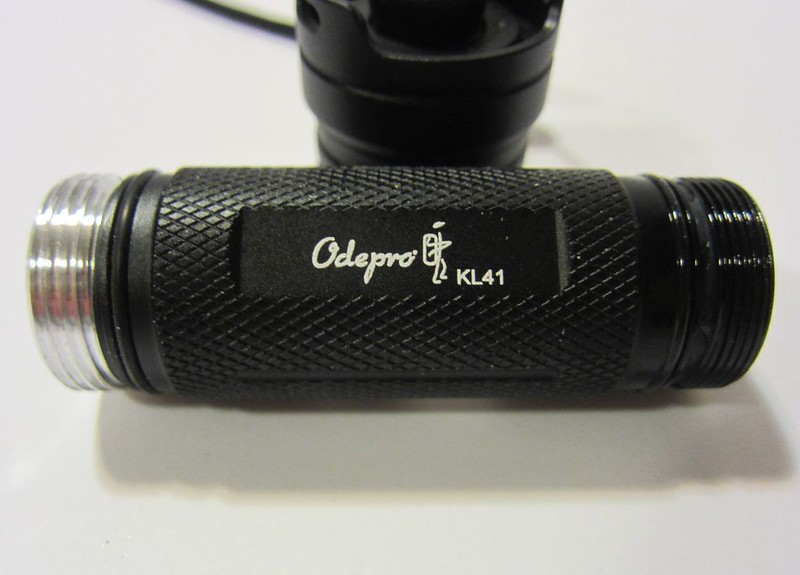
The size and shape of the KL41 is similar to C8 style lights but with a little extra length due to the deep reflector and the additional size of the swappable LED modules. I measured length at 7 inches, head diameter at just shy of 2 inches, and battery tube width at 1 inch. Weight without battery was measured at 235 grams or 8.3 ounces.
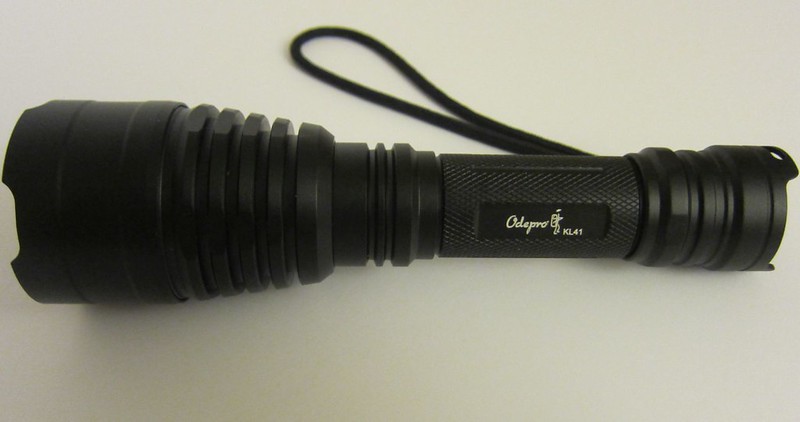
The head of the light features a mildly crenulated bezel. This allows light to escape if the light is placed head-down onto a surface. The head and tail are both round so the KL41 will roll on any reasonably smooth surface. The crenulations are blunt on the front so the KL41 won't mar most surfaces. The reflector is a very deep, smooth, reflector designed to give the KL41 long-range throw. I was impressed with the quality of the aluminum reflector; the finish was free of defects and produced a clean beam. The glass is AR-coated.
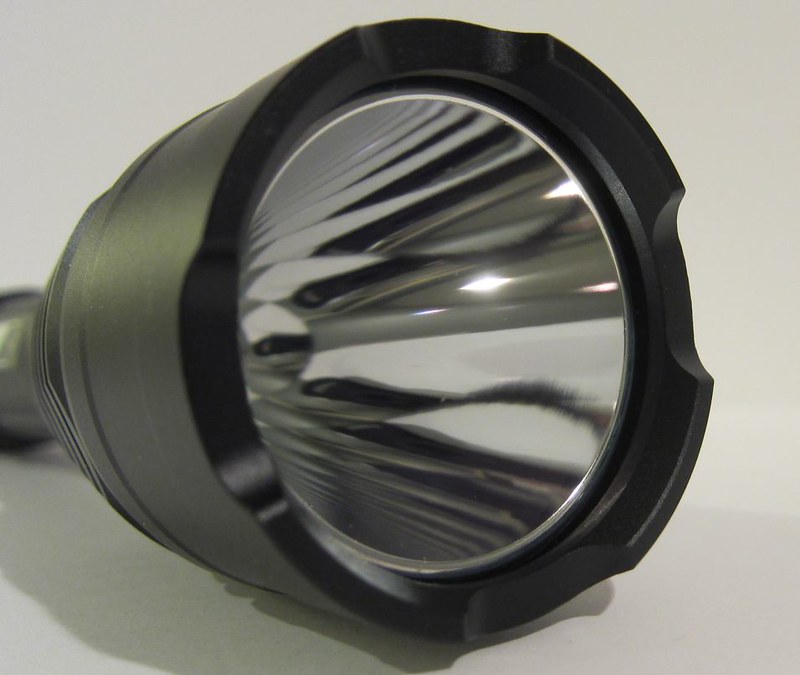
The LED was slightly off center but fairly close.
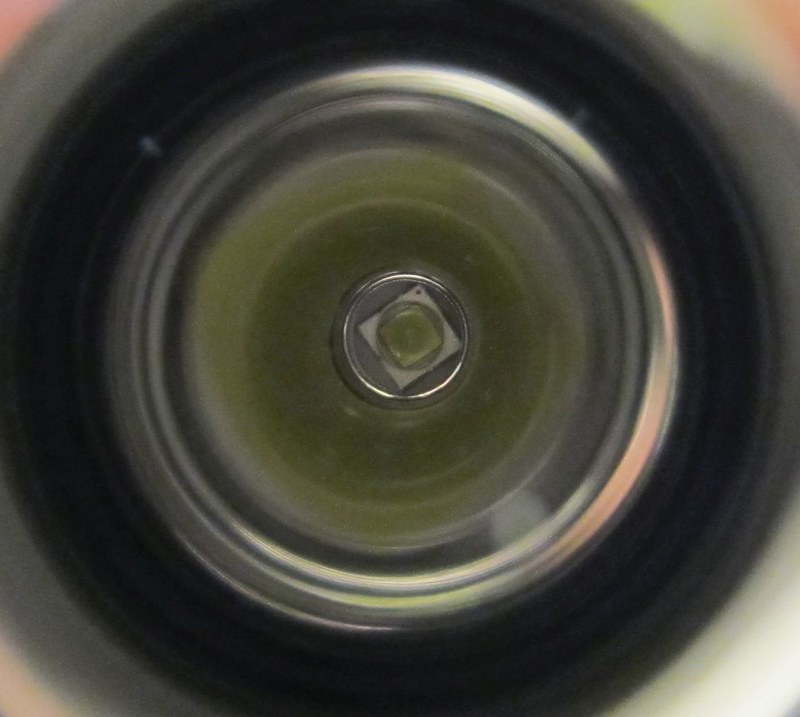
The KL41 has a forward clicky tail switch. The activation pressure was about average - neither too easy to press accidentally nor too difficult to press when desired. Being a forward clicky, momentary on is possible with a half-press. The tail has two U-shaped cutouts so the switch can be located easily while maintaining the ability to tailstand. There are single holes in each side for lanyard attachment. (The downside to single holes is that the lanyard cord can interfere with tailstanding.
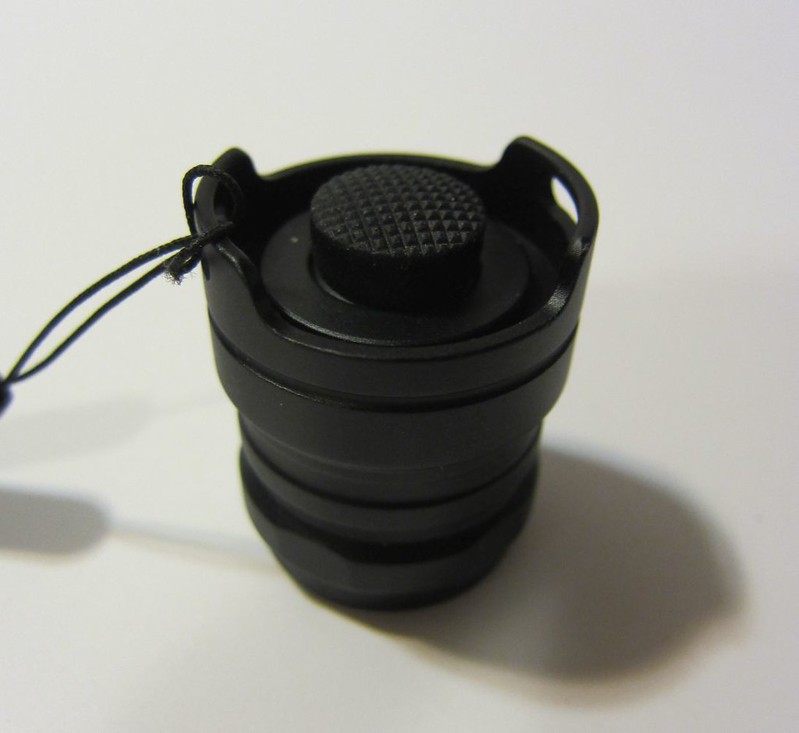
The tailcap has a nice gold-plated post. Lockout can be achieved with a simple quarter twist since the threads on the tube are anodized.

All threads are square cut. The threads on the tail end of the body tube are the only threads that arrived lubricated. All threads are anodized other than those that attach the body tube to the LED module. O-rings are present ahead of all threads as necessary to prevent water ingression and achieve the KL41's IP68 rating.


Here is the Odepro KL41 next to other flashlights, for comparison purposes. (Orcatorch T30, Nitecore EC4SW, Nitecore TM03, Odepro KL41, Thorfire C8S, Olight M3XS-UT)
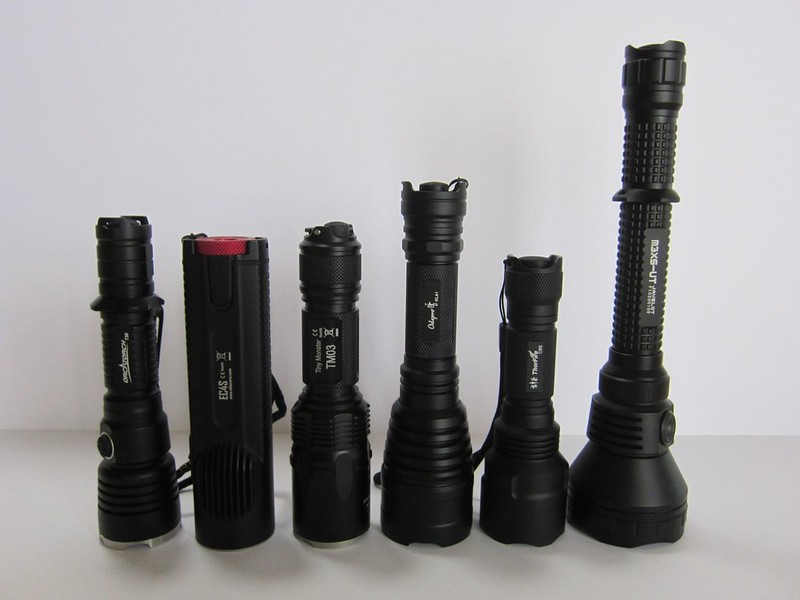
Looking at the heads of the same lights:

Performance
What's it look like when on? I found the temp to be quite cool, with some definite blues. The deep and smooth reflector helps it project a tight hot spot with comparatively wide corona and spill. (The transition from corona to spill is smooth.) The beam was quite clean and artifact-free. At 5.92 meters, I got a lux reading of 1399, equivalent to 49k Cd or 443 meters of throw. Odepro rates the KL41 at 38k Cd or 390 meters of throw, so the KL41 exceeded Odepro's specifications in my test sample.
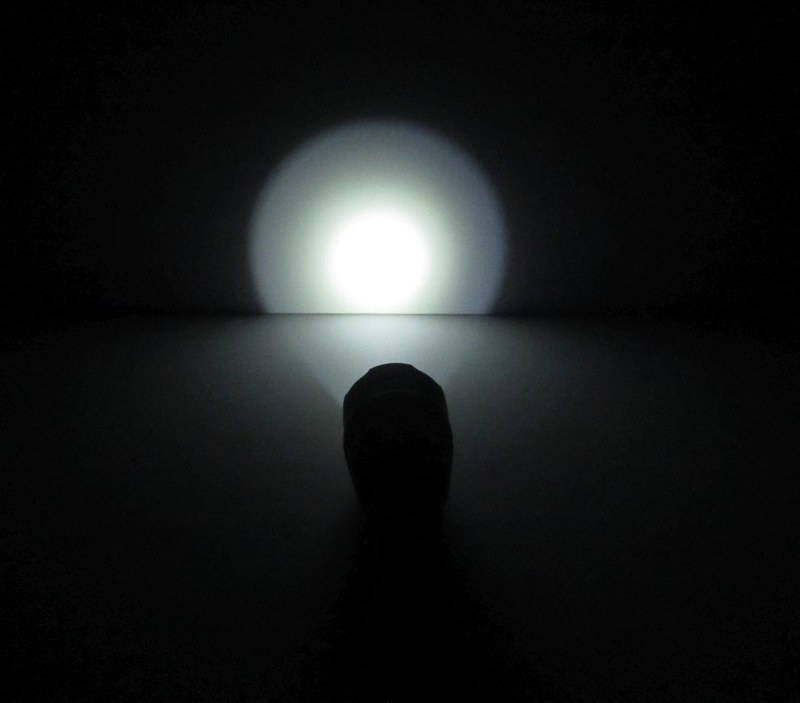
To show the color balance a little better, here is the KL41 with lights with emitters of various temps.
(Olight M3XS-UT, Thorfire C8S, Odepro KL41, Nitecore EC4SW, Lumintop Tool warm, BLF348)
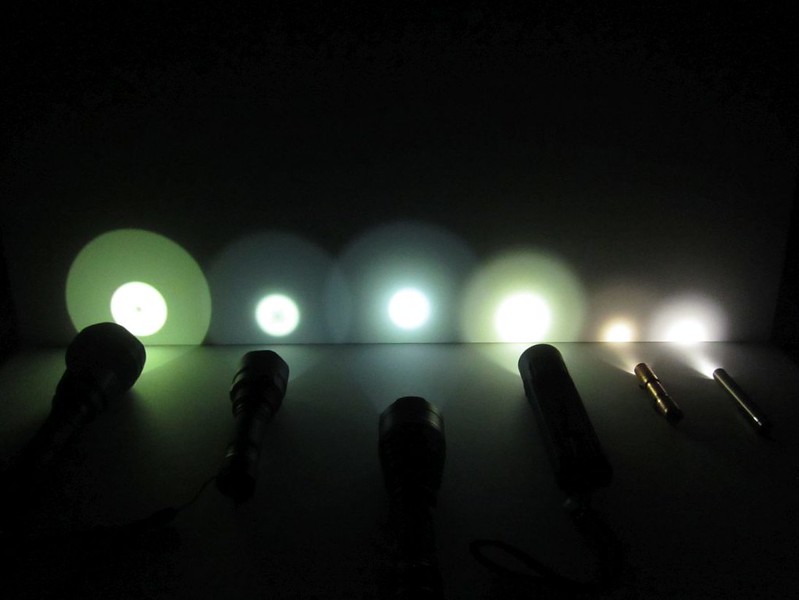
Red and green produced similar beam shapes – albeit in different colors than the XM-L2. Odepro rates the green at 200 lumens and the red at 150 lumens. My luxmeter (not calibrated for specific colors) read the equivalent of 170 lumens for green and 131 for the red. In this era of super-bright whites, these numbers don't sound impressive – but with the throwy reflector, the green and red both project light a lot further than most flashlights do with secondary reds and greens.
In runtime testing with the green, maintained about 160 lumen though 1:45, after which it slowly declined until it was under 17 lumens or 10% of the original output by 3:03. It then continued to output less and less for several hours. Battery protection did not trip as the battery declined to 2.43V under load.
Infrared is a specialty light and capturing it with a regular camera proved challenging. Thus, here are some images taken from an IP camera with IR capabilities. With the camera's own IR leds on, the full IR beam from the flashlight is visible on the wall.
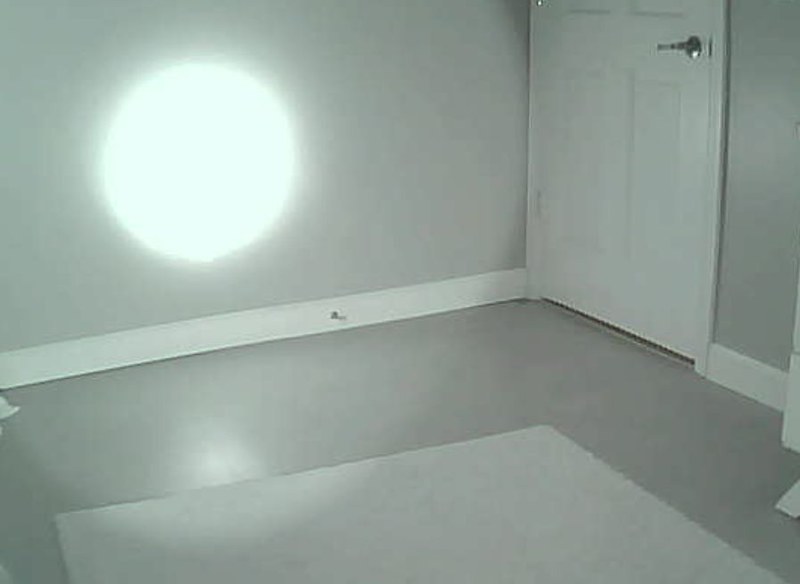
With the camera's own IR LEDs off, the security camera picked up and adjusted to the hotspot, this time shown in the leg of the dresser barely in the previous frame. As with the other LEDs, the deep reflector produces a tight hotspot.
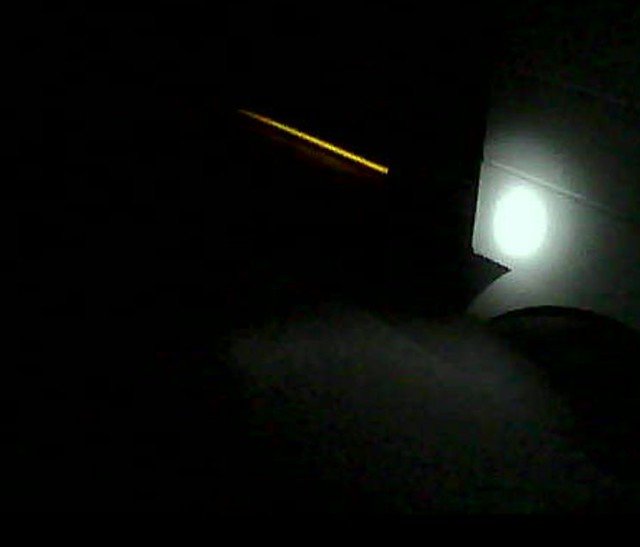
Most importantly, how does the light perform with the main XM-L2? Odepro rates the KL41 at 850 lumens on High. I tested it with a freshly-charged battery at 4.2V and was able to achieve a much higher 1023 lumens at 30 seconds. It held this level for about 5 minutes, then began a gradual decline. Just after one hour, a steep drop in output began until the battery was finished at minute 67. This is short of the 2.5hr runtime found in the product manual, though it is in line with what I'd expect based on the output and battery. Interestingly enough, the light did not go dark completely at minute 67. Instead, it began a slow and weak strobe. I immediately pulled the battery and found it to be at 3.05V.
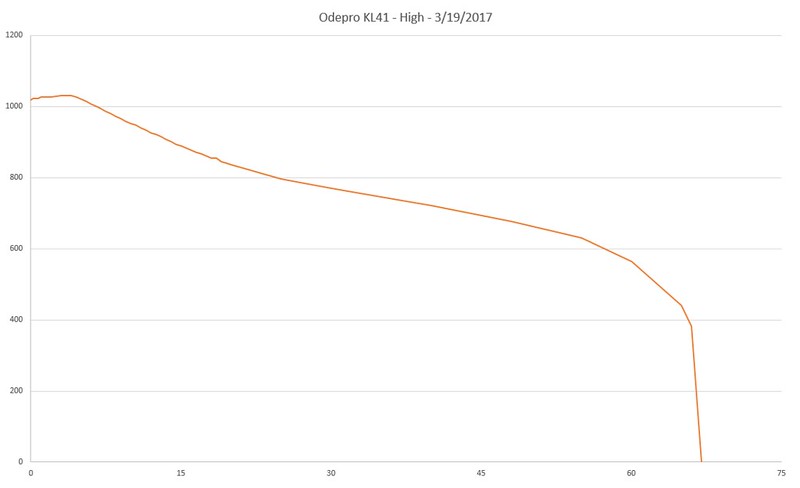
Medium is rated by Odepro at 310 lumens; I tested it at a slightly lower 295 lumens.
Low is reported at 33 lumens; I found 45 lumens in my testing. Runtime tests were not performed for the lower modes.
When left on the highest output, indoors at 72F with no airflow, tailstanding, the temperature of the light peaked at 118F. The hottest area was the cooling fins on the LED module. The entire light dissipated heat well with the head reaching 105F, the battery tube 109F, and the tail 107F. The KL41 remained comfortable to hold throughout. In hand and in normal use with natural airflow, the KL41 would remain even cooler.
The above tests were all performed with the included Odepro 18650 batteries. Odepro rates them at 3000mAh, though my Opus analyzing charger tested their capacities to be approximately 2600mAh.

As the Green module runtime test brought the battery under 2.5V without tripping the protection circuit, I removed the battery wrapping to take a closer look. I found that a typical protection circuit is indeed present with chip and strip.
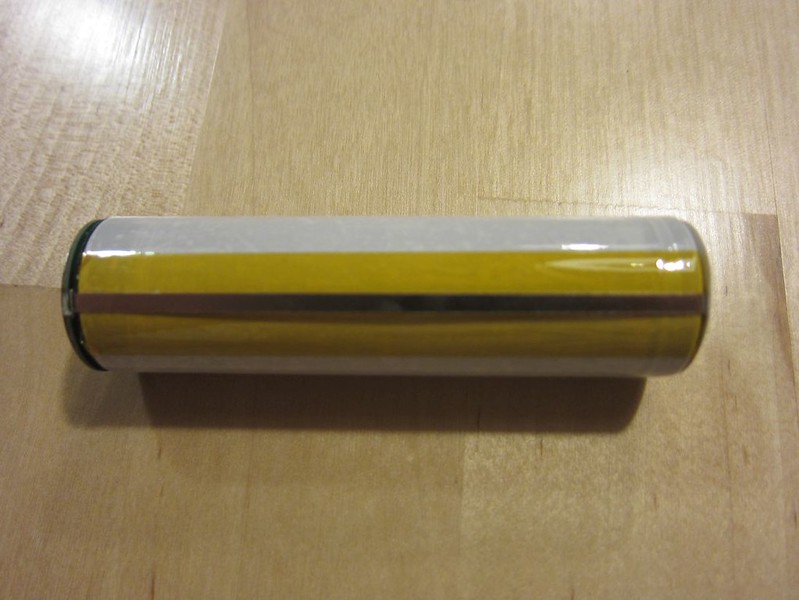
The manual makes no mention of CR123As so they were not tested.
Accessories
The KL41 Kit includes a Heseny HXY-18650-2A two-bay charger. It charges each battery at a maximum rate of 1A, per specifications, to 4.2V. CPF member HKJ performed a test of the 4.35V model from Heseny and found the charger worked fine though batteries should be removed once charged to avoid overcharging. This is a common budget charger included with several brands' flashlight kits. It cannot charge any sizes other than 18650.

Not done with accessories, the KL41 Kit includes a remote switch and a rifle mount. The remote switch has a similar high-quality post on the tail attachment. The switch itself actually has two buttons in the activation area, covered by heat-shrink tubing that carries some technical markings. Either button can be pressed to turn the light on and the light remains on as long as the button on the remote switch is held. The button end of the switch has a strip of adhesive hook-and-loop so the switch can be stuck to a gun or other surface. The click is audible but not loud.
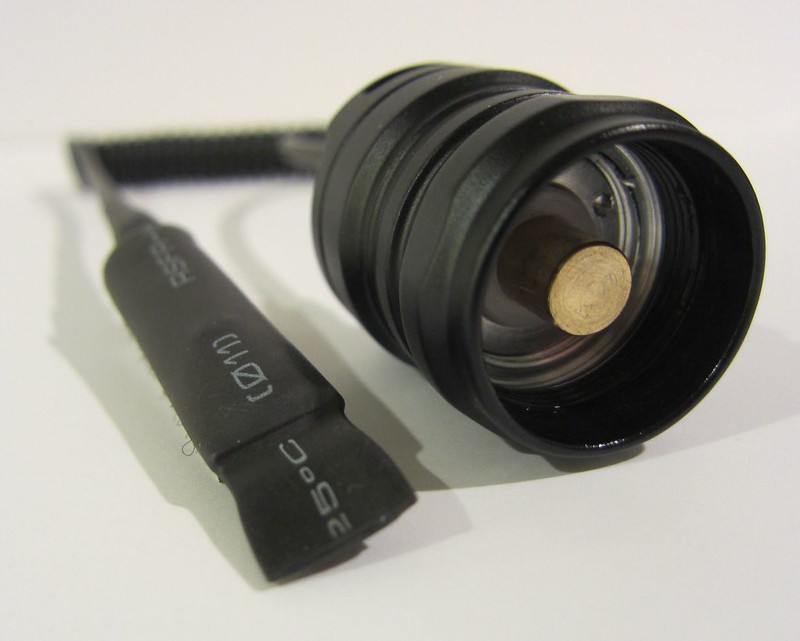
The rifle mount is designed to mount to a scope using the clamping plates, tightened by the included hex key. Or, it can mount to a rail tightened by the thumbscrew.

Interface
The KL41 is a simple one-button forward clicky design. On/off and mode selections are controlled from the tail switch.
A half press of the tailswitch will activate momentary on mode, in whatever the last used mode was. Pressing the button the rest of the way until the click is felt will leave the light on in that mode. Repeated half-presses in succession will switch between Low, Medium, High, Strobe, and SOS in this order. Some users would prefer that SOS and Strobe not be in the normal rotation, as cycling from High back to Low requires going through these modes.
Problems
The design of the KL41, with user-swappable LED modules, has an inherent weakness – the emitters and stars themselves are not protected from the user and environment during swaps. Also, the tolerances have to be tight to ensure the various LEDs all fit nicely with the single reflector. To accommodate this, Odepro designed the LED modules to have small plastic pieces around the emitters. These fit the square emitter on bottom yet have a round forward protrusion to match the reflector and are stuck to the stars with adhesive. Around the circular part, a paper-based disc acts as an insulator – preventing the aluminum reflector from contacting the leads from the battery directly.
When I first tried to use the green module, I noticed that the aforementioned ring had come loose in transit. I replaced it, but then found a bigger problem when I swapped from the red module (as shipped) to the green module: the emitter came right off the star and got stuck in the head!
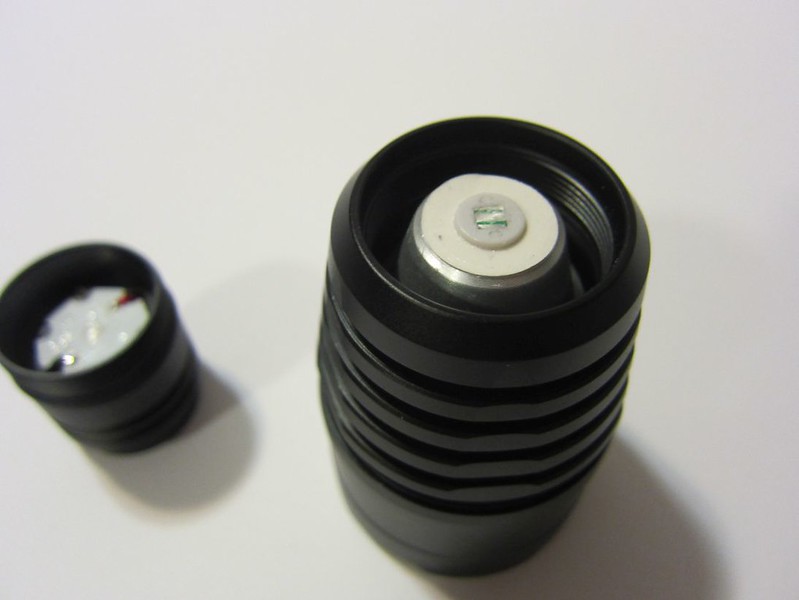
This is a serious concern, and working through what happened, I discovered that the KL41 is picky about head tightness. While the tail can be fully screwed onto the battery tube – and the battery tube can be fully screwed into the LED module – the head cannot be fully screwed onto the LED module without causing damage. It should be tightened only to the point where increased resistance is felt. The tolerances are too tight and the base of the reflector can grab the plastic disc and force the LED to turn, detaching it from the star, if the head is tightened "all the way."
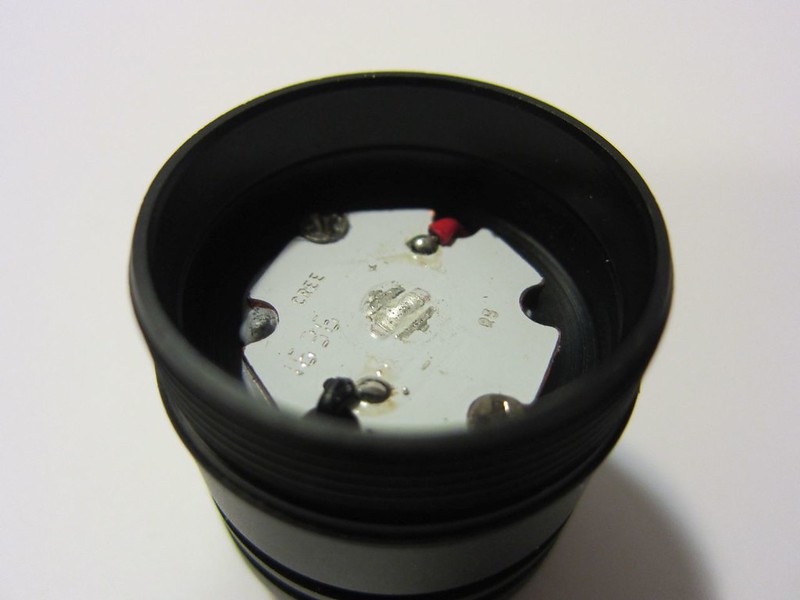
I contacted Odepro and asked them how they'd like to handle the situation; they asked and I agreed to make an attempt to fix it myself. Using a 40W soldering iron, I removed the positive and negative leads on the star. I then removed the two screws holding the star down before lifting and removing it and wiping the heatsink compound off the rear. I positioned the emitter back on the copper star in the correct orientation, using the small black dot in the corner to tell polarity and the red module as a template.
With the emitter placed on the star, I placed the star on a hotplate and warmed the plate to 425 degrees. At about this temperature, the LED self-aligned and was reflowed to the star, simple as that. I turned the control off and let the star cool before returning it to the light. A bit of heatsink paste, two screws, the power wires reattached using the original solder, and functionality was restored. No, none of this was ideal, but it demonstrates that nothing more than a soldering iron was absolutely necessary to fix it.
The white paper disc circling the LED is required to prevent the base of the reflector from rubbing on the power wires. The paper disc shows wear quickly from friction against the reflector base.

Without the disc in place, the reflector can contact the power wires and cause a potential short circuit. Here you can see flat spots on the solder due to the reflector.

When discussing the problem with Odepro, they acknowledged that other customers had experienced the same problem – and they were now making a 1mm adjustment to increase the tolerances and reduce these occurrences. Hopefully Odepro will seek a review on the revised model as well.
Commentary
Odepro appears to be making a strong attempt to establish itself as a solid flashlight maker. Since the middle of 2016, they've created several flashlights, taken up an online presence, and joined CPF to seek feedback.
The KL41 has many excellent qualities. The reflector is excellent. AR-coated glass is nice. The springs are good quality. The emitters are mounted on copper and the light has good heat management. Spare o-rings are included. The box is better than most and has a padded place for everything, including jars to protect the LED modules. The multiple emitter options give tremendous flexibility.
I don't know of any more cost effective way to acquire white, red, green, and IR flashlights with batteries at this price point. And the output on High exceeds expectations!
Unfortunately, the fragility of the emitters due to the design of the ring around the emitter and reflector makes me nervous to depend on this light. Swapping the modules is not easy in the field, so I would expect most users to use and bring only a single emitter at a time when heading out with the KL41. To have to be conscientious about not tightening the head seems counterintuitive when heads on all other flashlights need to be tight. Also, the underperforming batteries, inconsistent thread lubrication, lack of instructions and branded heat-shrink tubing on the remote switch show areas that are not yet perfected. Odepro also needs to resolve scripting issues on their website that has triggered Google to flag Odepro.com as a dangerous website, preventing access to the user manual for most users.
This leads me to conclude that the KL41 seems like a valiant 1st gen effort that could be bettered significantly with some simple modifications – some of which Odepro has reported are already in progress.
Odepro KL41 Kit provided by OdeproOutdoor for review.
Lux Meter : Dr. Meter LX1330
Integrating sphere: Homebuilt "tube" calibrated to known lights
Introduction
Odepro is a flashlight manufacturer I first learned of earlier this month after OdeproOutdoor became active on CPF. I volunteered to review the KL41, one of several models of flashlights that Odepro manufactures.
This light was provided by OdeproOutdoor for review and shipped from an Amazon distribution center in the U.S. The KL41 being reviewed here is the Kit version and includes a remote switch, 2 batteries, and a 2-bay charger.
Here's the key review details in one table:

Packaging
The KL41 kit arrived in a well-made gloss black box with a magnetic clasp and sufficient padding for all of the components included. It is not a travel case per se, but it did a good job protecting the contents while in transit and held up to several dozen cycles of opening and closing while I was performing this review. Unfortunately, the box included no instructions or user manuals, though spare o-rings were included.


Here is the user manual from Odepro's website:

Design
The KL41 is marketed by Odepro as a "Super Bright Long-range Tactical Hunting Flashlight." How can it be long-range, tactical, and hunting all at the same time? A very unique approach – user swappable LED modules. Separate modules are included for the WHITE (XM-L2), RED (XR-E), GREEN (XR-E), and INFRARED (Osram) emitters. Each has its own battery spring, driver, and emitter. White, green, and infrared modules are labeled, though red curiously lacks any such distinction.

Each LED module is packaged in its own storage jar with foam inserts to cushion the module and protect the LED. The emitter itself is mounted to a copper star of thickness between 1.5-2.0mm. Sufficient thermal paste was applied between the star and body to ensure good heat transfer.

Unlike other lights that tuck colored LEDs into the walls of the reflector, the KL41 uses one emitter at a time as selected and assembled by the user. The advantage is that the full reflector can be utilized – producing an artifact-free beam and achieving long throws regardless of emitter. The disadvantage is that swapping between LEDs means disassembling the flashlight and then reassembling with the alternate LED module. As discussed in the Problem section later, this design decision introduces a point of possible failure that I experienced while performing this review.

The LED modules each contain gold-plated springs for the positive end of the battery. The KL41's manual reports that the light has polarity protection; I did not test this to confirm.

The KL41 disassembles into 4 pieces in total: head, LED module, body tube, and tail.

The Odepro logo and model number are printed on the side of the battery tube along with an image on the opposite side showing the correct battery orientation. The anodization and printing were both excellent and free of defects. The diamond pattern knurling is one of the least aggressive I've seen. With the larger head and tailcap I don't see slippage being a real problem, but the knurling itself is nearly smooth.

The size and shape of the KL41 is similar to C8 style lights but with a little extra length due to the deep reflector and the additional size of the swappable LED modules. I measured length at 7 inches, head diameter at just shy of 2 inches, and battery tube width at 1 inch. Weight without battery was measured at 235 grams or 8.3 ounces.

The head of the light features a mildly crenulated bezel. This allows light to escape if the light is placed head-down onto a surface. The head and tail are both round so the KL41 will roll on any reasonably smooth surface. The crenulations are blunt on the front so the KL41 won't mar most surfaces. The reflector is a very deep, smooth, reflector designed to give the KL41 long-range throw. I was impressed with the quality of the aluminum reflector; the finish was free of defects and produced a clean beam. The glass is AR-coated.

The LED was slightly off center but fairly close.

The KL41 has a forward clicky tail switch. The activation pressure was about average - neither too easy to press accidentally nor too difficult to press when desired. Being a forward clicky, momentary on is possible with a half-press. The tail has two U-shaped cutouts so the switch can be located easily while maintaining the ability to tailstand. There are single holes in each side for lanyard attachment. (The downside to single holes is that the lanyard cord can interfere with tailstanding.

The tailcap has a nice gold-plated post. Lockout can be achieved with a simple quarter twist since the threads on the tube are anodized.

All threads are square cut. The threads on the tail end of the body tube are the only threads that arrived lubricated. All threads are anodized other than those that attach the body tube to the LED module. O-rings are present ahead of all threads as necessary to prevent water ingression and achieve the KL41's IP68 rating.


Here is the Odepro KL41 next to other flashlights, for comparison purposes. (Orcatorch T30, Nitecore EC4SW, Nitecore TM03, Odepro KL41, Thorfire C8S, Olight M3XS-UT)

Looking at the heads of the same lights:

Performance
What's it look like when on? I found the temp to be quite cool, with some definite blues. The deep and smooth reflector helps it project a tight hot spot with comparatively wide corona and spill. (The transition from corona to spill is smooth.) The beam was quite clean and artifact-free. At 5.92 meters, I got a lux reading of 1399, equivalent to 49k Cd or 443 meters of throw. Odepro rates the KL41 at 38k Cd or 390 meters of throw, so the KL41 exceeded Odepro's specifications in my test sample.

To show the color balance a little better, here is the KL41 with lights with emitters of various temps.
(Olight M3XS-UT, Thorfire C8S, Odepro KL41, Nitecore EC4SW, Lumintop Tool warm, BLF348)

Red and green produced similar beam shapes – albeit in different colors than the XM-L2. Odepro rates the green at 200 lumens and the red at 150 lumens. My luxmeter (not calibrated for specific colors) read the equivalent of 170 lumens for green and 131 for the red. In this era of super-bright whites, these numbers don't sound impressive – but with the throwy reflector, the green and red both project light a lot further than most flashlights do with secondary reds and greens.
In runtime testing with the green, maintained about 160 lumen though 1:45, after which it slowly declined until it was under 17 lumens or 10% of the original output by 3:03. It then continued to output less and less for several hours. Battery protection did not trip as the battery declined to 2.43V under load.
Infrared is a specialty light and capturing it with a regular camera proved challenging. Thus, here are some images taken from an IP camera with IR capabilities. With the camera's own IR leds on, the full IR beam from the flashlight is visible on the wall.

With the camera's own IR LEDs off, the security camera picked up and adjusted to the hotspot, this time shown in the leg of the dresser barely in the previous frame. As with the other LEDs, the deep reflector produces a tight hotspot.

Most importantly, how does the light perform with the main XM-L2? Odepro rates the KL41 at 850 lumens on High. I tested it with a freshly-charged battery at 4.2V and was able to achieve a much higher 1023 lumens at 30 seconds. It held this level for about 5 minutes, then began a gradual decline. Just after one hour, a steep drop in output began until the battery was finished at minute 67. This is short of the 2.5hr runtime found in the product manual, though it is in line with what I'd expect based on the output and battery. Interestingly enough, the light did not go dark completely at minute 67. Instead, it began a slow and weak strobe. I immediately pulled the battery and found it to be at 3.05V.

Medium is rated by Odepro at 310 lumens; I tested it at a slightly lower 295 lumens.
Low is reported at 33 lumens; I found 45 lumens in my testing. Runtime tests were not performed for the lower modes.
When left on the highest output, indoors at 72F with no airflow, tailstanding, the temperature of the light peaked at 118F. The hottest area was the cooling fins on the LED module. The entire light dissipated heat well with the head reaching 105F, the battery tube 109F, and the tail 107F. The KL41 remained comfortable to hold throughout. In hand and in normal use with natural airflow, the KL41 would remain even cooler.
The above tests were all performed with the included Odepro 18650 batteries. Odepro rates them at 3000mAh, though my Opus analyzing charger tested their capacities to be approximately 2600mAh.

As the Green module runtime test brought the battery under 2.5V without tripping the protection circuit, I removed the battery wrapping to take a closer look. I found that a typical protection circuit is indeed present with chip and strip.

The manual makes no mention of CR123As so they were not tested.
Accessories
The KL41 Kit includes a Heseny HXY-18650-2A two-bay charger. It charges each battery at a maximum rate of 1A, per specifications, to 4.2V. CPF member HKJ performed a test of the 4.35V model from Heseny and found the charger worked fine though batteries should be removed once charged to avoid overcharging. This is a common budget charger included with several brands' flashlight kits. It cannot charge any sizes other than 18650.

Not done with accessories, the KL41 Kit includes a remote switch and a rifle mount. The remote switch has a similar high-quality post on the tail attachment. The switch itself actually has two buttons in the activation area, covered by heat-shrink tubing that carries some technical markings. Either button can be pressed to turn the light on and the light remains on as long as the button on the remote switch is held. The button end of the switch has a strip of adhesive hook-and-loop so the switch can be stuck to a gun or other surface. The click is audible but not loud.

The rifle mount is designed to mount to a scope using the clamping plates, tightened by the included hex key. Or, it can mount to a rail tightened by the thumbscrew.

Interface
The KL41 is a simple one-button forward clicky design. On/off and mode selections are controlled from the tail switch.
A half press of the tailswitch will activate momentary on mode, in whatever the last used mode was. Pressing the button the rest of the way until the click is felt will leave the light on in that mode. Repeated half-presses in succession will switch between Low, Medium, High, Strobe, and SOS in this order. Some users would prefer that SOS and Strobe not be in the normal rotation, as cycling from High back to Low requires going through these modes.
Problems
The design of the KL41, with user-swappable LED modules, has an inherent weakness – the emitters and stars themselves are not protected from the user and environment during swaps. Also, the tolerances have to be tight to ensure the various LEDs all fit nicely with the single reflector. To accommodate this, Odepro designed the LED modules to have small plastic pieces around the emitters. These fit the square emitter on bottom yet have a round forward protrusion to match the reflector and are stuck to the stars with adhesive. Around the circular part, a paper-based disc acts as an insulator – preventing the aluminum reflector from contacting the leads from the battery directly.
When I first tried to use the green module, I noticed that the aforementioned ring had come loose in transit. I replaced it, but then found a bigger problem when I swapped from the red module (as shipped) to the green module: the emitter came right off the star and got stuck in the head!

This is a serious concern, and working through what happened, I discovered that the KL41 is picky about head tightness. While the tail can be fully screwed onto the battery tube – and the battery tube can be fully screwed into the LED module – the head cannot be fully screwed onto the LED module without causing damage. It should be tightened only to the point where increased resistance is felt. The tolerances are too tight and the base of the reflector can grab the plastic disc and force the LED to turn, detaching it from the star, if the head is tightened "all the way."

I contacted Odepro and asked them how they'd like to handle the situation; they asked and I agreed to make an attempt to fix it myself. Using a 40W soldering iron, I removed the positive and negative leads on the star. I then removed the two screws holding the star down before lifting and removing it and wiping the heatsink compound off the rear. I positioned the emitter back on the copper star in the correct orientation, using the small black dot in the corner to tell polarity and the red module as a template.
With the emitter placed on the star, I placed the star on a hotplate and warmed the plate to 425 degrees. At about this temperature, the LED self-aligned and was reflowed to the star, simple as that. I turned the control off and let the star cool before returning it to the light. A bit of heatsink paste, two screws, the power wires reattached using the original solder, and functionality was restored. No, none of this was ideal, but it demonstrates that nothing more than a soldering iron was absolutely necessary to fix it.
The white paper disc circling the LED is required to prevent the base of the reflector from rubbing on the power wires. The paper disc shows wear quickly from friction against the reflector base.

Without the disc in place, the reflector can contact the power wires and cause a potential short circuit. Here you can see flat spots on the solder due to the reflector.

When discussing the problem with Odepro, they acknowledged that other customers had experienced the same problem – and they were now making a 1mm adjustment to increase the tolerances and reduce these occurrences. Hopefully Odepro will seek a review on the revised model as well.
Commentary
Odepro appears to be making a strong attempt to establish itself as a solid flashlight maker. Since the middle of 2016, they've created several flashlights, taken up an online presence, and joined CPF to seek feedback.
The KL41 has many excellent qualities. The reflector is excellent. AR-coated glass is nice. The springs are good quality. The emitters are mounted on copper and the light has good heat management. Spare o-rings are included. The box is better than most and has a padded place for everything, including jars to protect the LED modules. The multiple emitter options give tremendous flexibility.
I don't know of any more cost effective way to acquire white, red, green, and IR flashlights with batteries at this price point. And the output on High exceeds expectations!
Unfortunately, the fragility of the emitters due to the design of the ring around the emitter and reflector makes me nervous to depend on this light. Swapping the modules is not easy in the field, so I would expect most users to use and bring only a single emitter at a time when heading out with the KL41. To have to be conscientious about not tightening the head seems counterintuitive when heads on all other flashlights need to be tight. Also, the underperforming batteries, inconsistent thread lubrication, lack of instructions and branded heat-shrink tubing on the remote switch show areas that are not yet perfected. Odepro also needs to resolve scripting issues on their website that has triggered Google to flag Odepro.com as a dangerous website, preventing access to the user manual for most users.
This leads me to conclude that the KL41 seems like a valiant 1st gen effort that could be bettered significantly with some simple modifications – some of which Odepro has reported are already in progress.
Odepro KL41 Kit provided by OdeproOutdoor for review.
Lux Meter : Dr. Meter LX1330
Integrating sphere: Homebuilt "tube" calibrated to known lights
Last edited:

